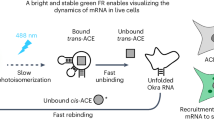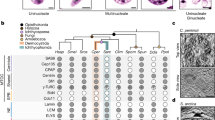Abstract
Porphyridium purpureum (Bory) Drew et Ross (Syn.: P. cruentum Nägeli) is a classical laboratory organism and one of the few red algae easily grown in large quantities. This would make it an obvious candidate for investigation of red algal mitosis with the electron microscope. The nuclei are, however, quite small and fast dividing, so that previous attempts remained apparently unsuccessful1,2 and left the much more complex species Membranoptera platyphylla the only red alga where mitosis had been satisfactorily described3. We are now able to report that mitosis in Porphyridium is not only quite distinct from that in Membranoptera but also presents an unique association of microbodies with the spindle poles.
This is a preview of subscription content, access via your institution
Access options
Subscribe to this journal
Receive 51 print issues and online access
$199.00 per year
only $3.90 per issue
Buy this article
- Purchase on Springer Link
- Instant access to full article PDF
Prices may be subject to local taxes which are calculated during checkout
Similar content being viewed by others
References
Chapman, R. L., Chapman, M. R. & Lang, N. J. J. Phycol. 7, suppl. 3 (1971).
Chapman, R. L. & Lang, N. J. J. Phycol. 9, 117–122 (1973).
McDonald, K. J. Phycol. 8, 156–166 (1972).
Jones, R. F., Speer, H. L. & Kury, W. Physiol. Pl. 16, 636–643 (1963).
Gense, M. T., Guérin-Dumartrait, E., Leclerc, J. C. & Mihara, S. Phycologia 8, 135–141 (1969).
Knappe, J. Ber. Deutsch. Bot. Ges. 85, 425–434 (1973).
Allen, E. D., Lowry, R. J. & Sussman, A. S. J. ultr. Res. 48, 455–464 (1974).
Ellzey, J., Huizar, E. & Yanez, D. Archs Microbiol. 107, 113–114 (1976).
Schnepf, E., Deichgräber, G. & Ettl, H. Pl. Syst. Ecol. 125, 109–121 (1976).
Franke, W. W. & Reau, P. Archs Mikrobiol. 90, 121–129 (1973).
Pearson, B. R. & Norris, R. E. J. Phycol. 11, 113–124 (1975).
Oakley, B. R. & Dodge, J. D. Protoplasma 80, 233–244 (1974).
Setliff, E. C., Hock, H. C. & Patton, R. F. Can. J. Bot. 52, 2323–2333 (1974).
Dodge, J. D. The Fine Structure of Algal Cells (Academic, London and New York, 1973).
Kubai, D. F. Int. Rev. Cytol. 43, 167–227 (1973).
Fuller, M. S. Int. Rev. Cytol. 45, 113–153 (1976).
Oakley, B. R. & Dodge, J. D. Nature 244, 521–522 (1973).
Lee, R. E. Nature 247, 300 (1974).
Oakley, B. R. & Dodge, J. D. Nature 247, 300–301 (1974).
Author information
Authors and Affiliations
Rights and permissions
About this article
Cite this article
BRONCHART, R., DEMOULIN, V. Unusual mitosis in the red alga Porphyridium purpureum. Nature 268, 80–81 (1977). https://doi.org/10.1038/268080a0
Received:
Accepted:
Published:
Issue Date:
DOI: https://doi.org/10.1038/268080a0
This article is cited by
-
Ultrastructure of cell division and reproductive differentiation of male plants in theFlorideophyceae (Rhodophyta). Mitosis inDasya baillouviana
Protoplasma (1981)
-
Reevaluation of mitosis in the red alga Porphyridium purpureum
Nature (1980)
-
Evidence for two classes of microbodies in meiocytes of the red algaPalmaria palmata
Protoplasma (1980)
-
Ultrastructural changes in major organelles during spermatial differentiation inBangia (Rhodophyta)
Protoplasma (1980)
Comments
By submitting a comment you agree to abide by our Terms and Community Guidelines. If you find something abusive or that does not comply with our terms or guidelines please flag it as inappropriate.



